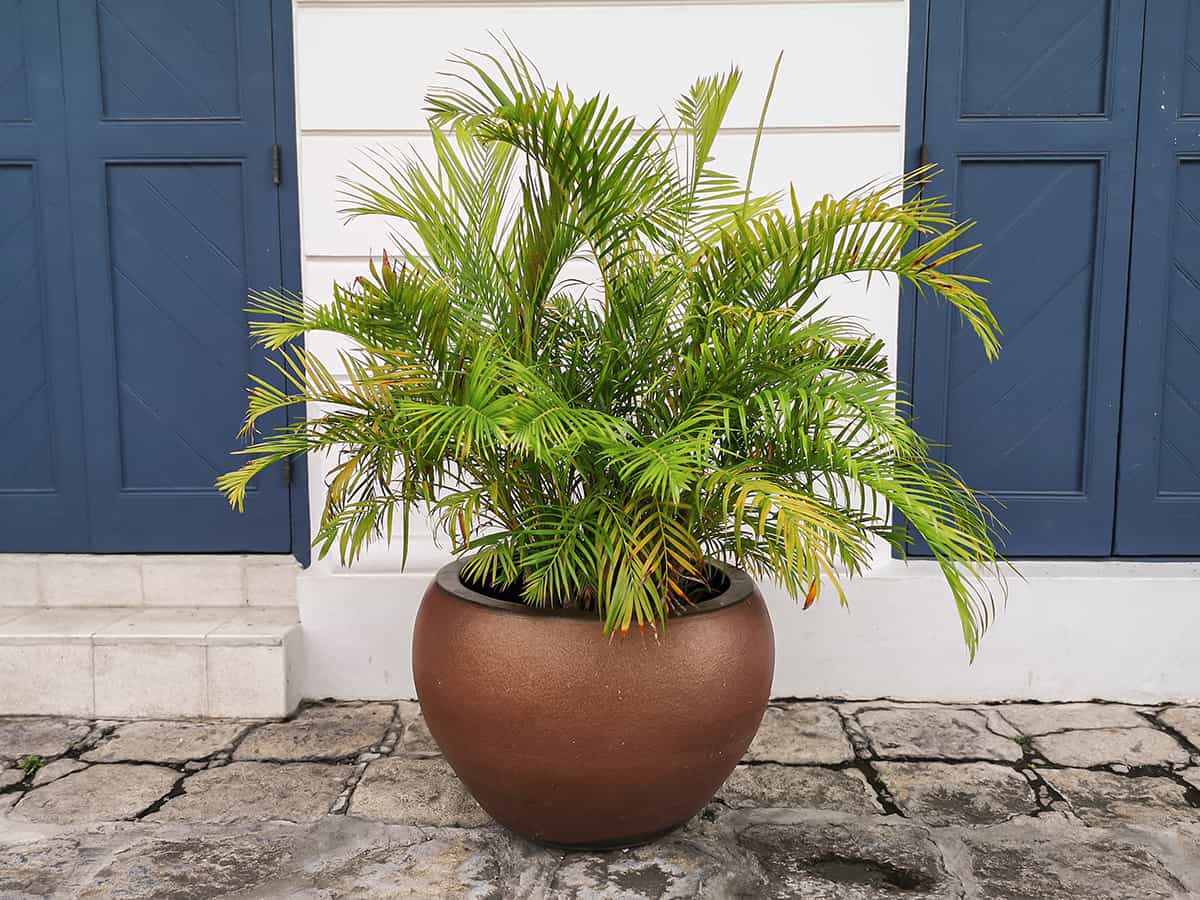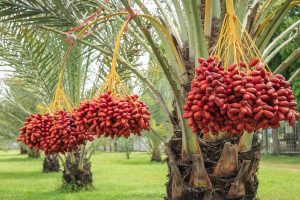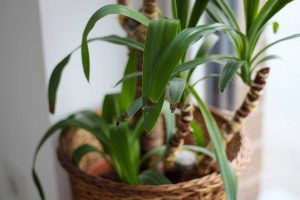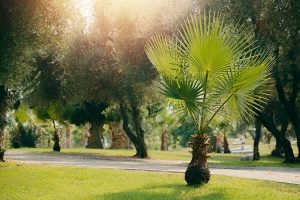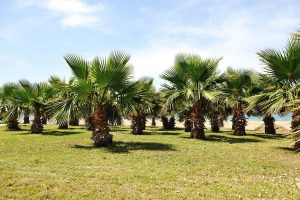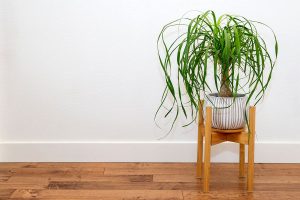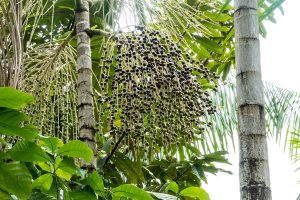Palms are great plants to keep in outdoor pots to create a tropical vibe on a patio or provide shade to nearby borders. Many types of palms are well suited to growing in a container, which we will explore here.
Table of Contents
Best Palms for Outdoor Pots
There are over 2500 different species of palms, and many of them are extremely well suited to growing in an outdoor pot. Here we look at the best types of outdoor potted palms.
Kentia Palm
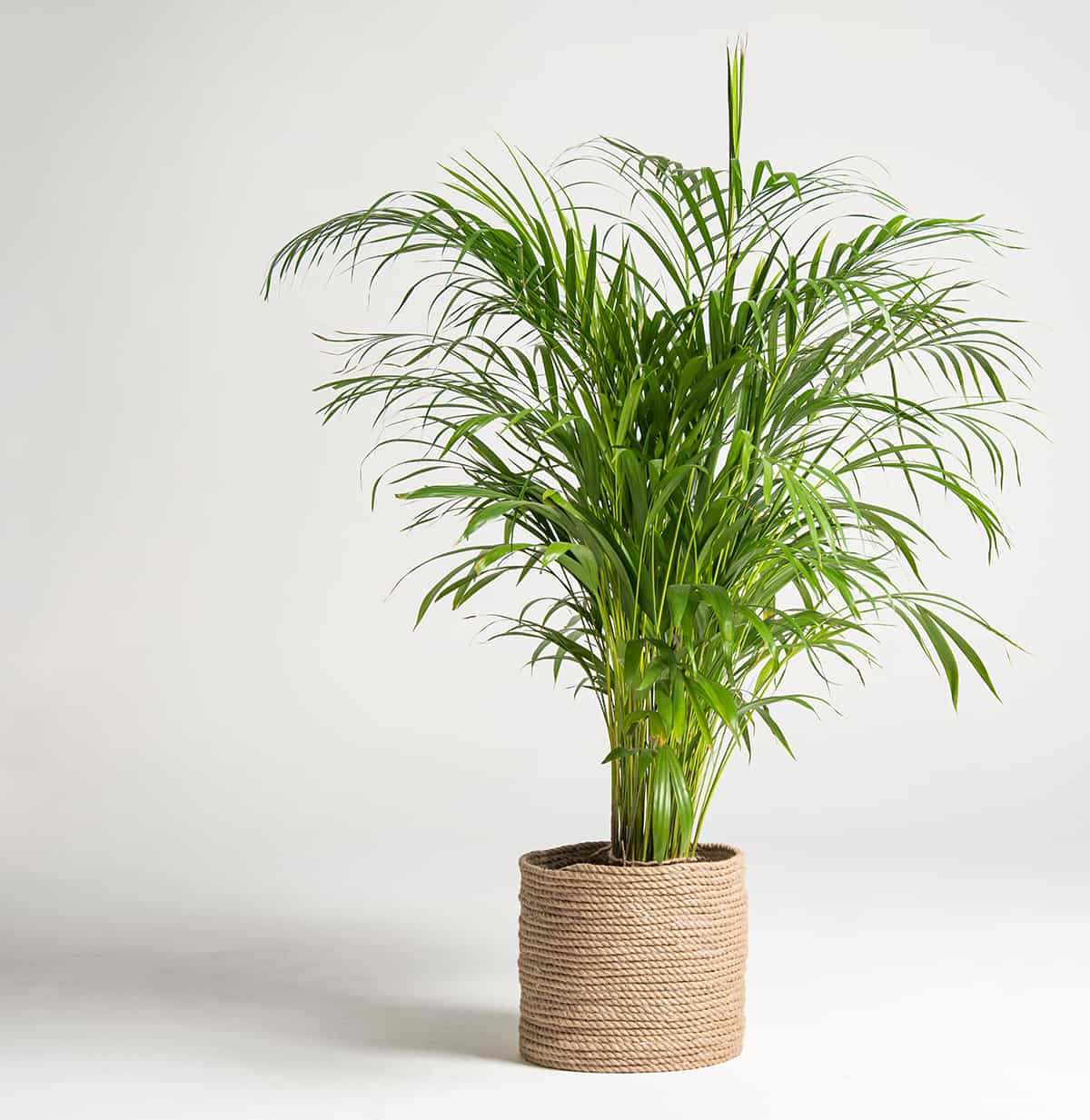
| Botanical name | Howea forsteriana |
| USDA hardiness zone | 9- 11 |
| Mature height in a pot | 25 feet |
The Kentia Palm is endemic to a tiny island in Australia. It grows very slowly, which makes it ideally suited to life in a pot. This is an easy care palm because it can adapt well to a variety of situations.
It thrives in moist soils, but it can also tolerate short periods of drought. Unlike many types of palm, it prefers shady conditions, so position it beneath the shade of taller trees or beneath a porch. The Kentia Palm features dark green foliage in pinnate feathery fronds.
Areca Palm
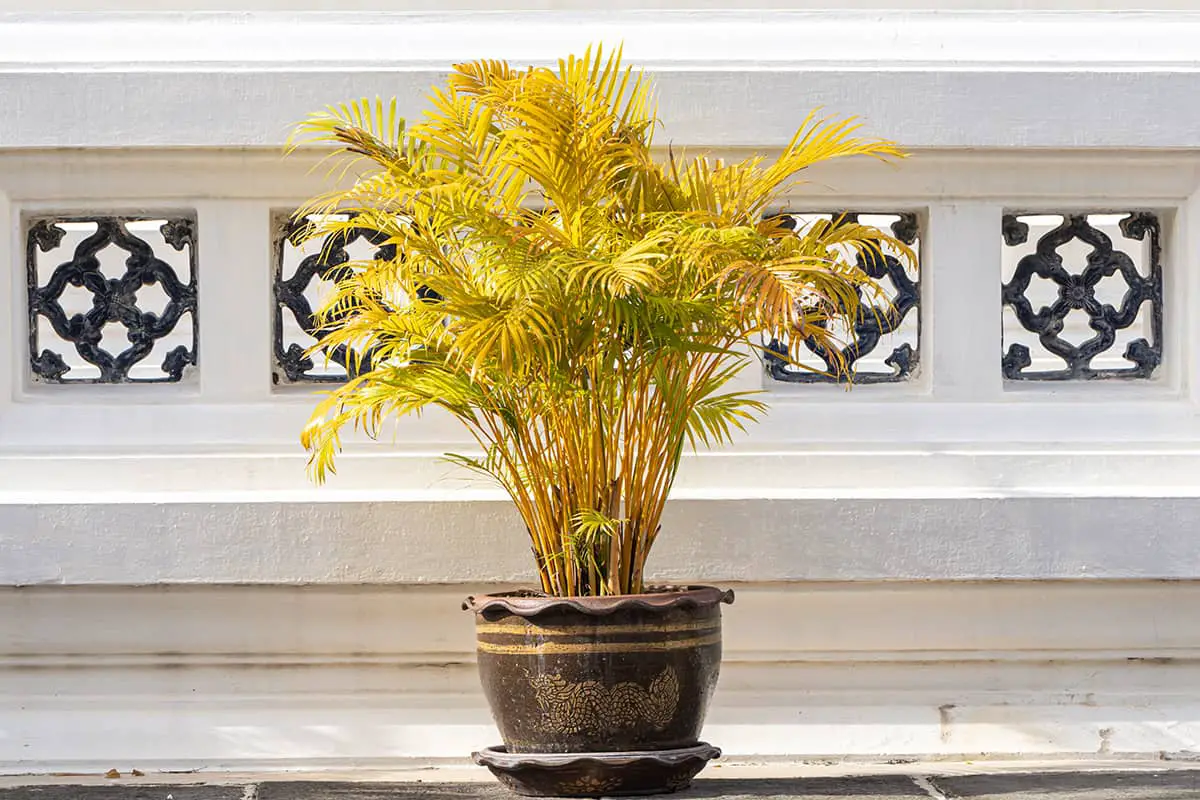
| Botanical name | Dypsis lutescens |
| USDA hardiness zone | 10 – 11 |
| Mature height in a pot | 20 feet |
The Areca Palm is very popular for growing in a pot. It produces dense clumps of foliage which make it a nice choice for creating a privacy screen or a shaded area. It enjoys partial shade to full sun and is a moisture-loving plant.
Ponytail Palm
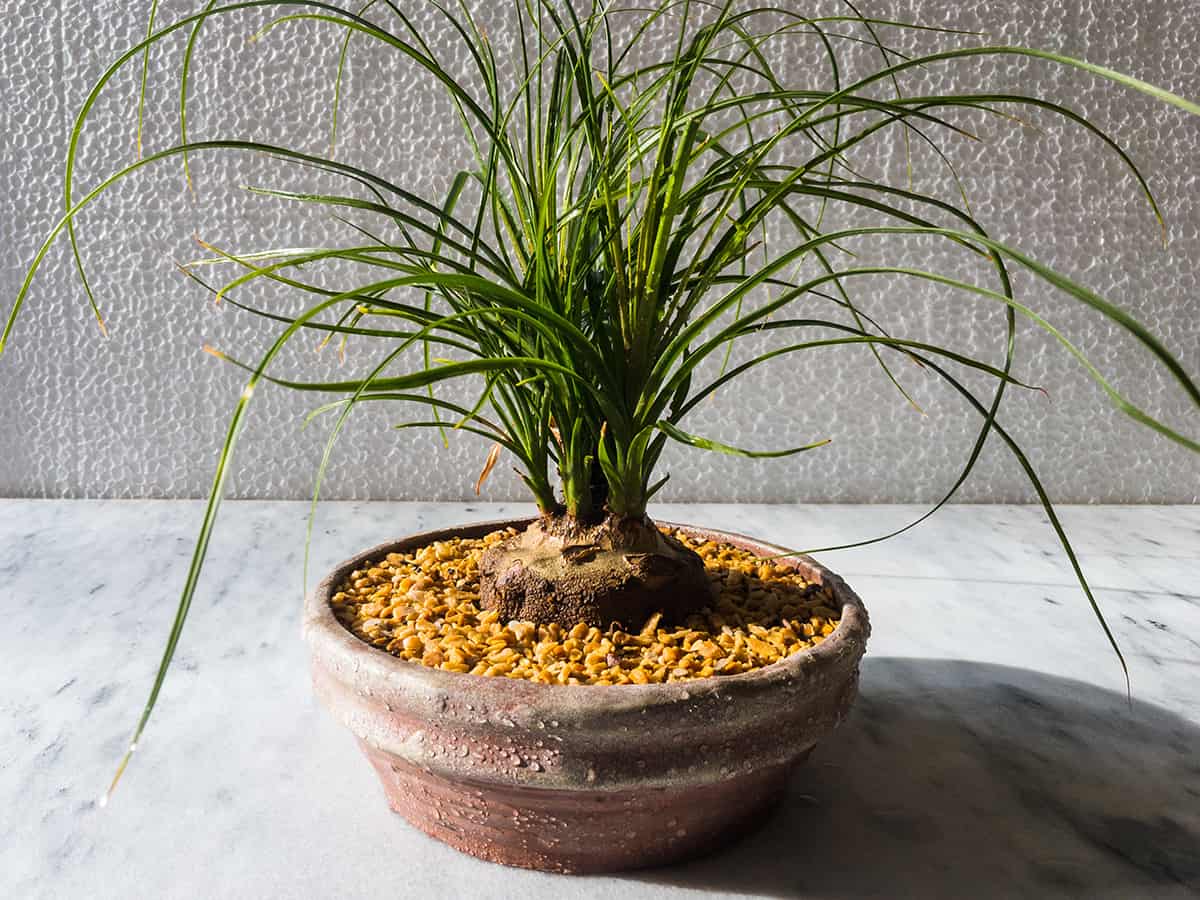
| Botanical name | Beaucarnea recurvata |
| USDA hardiness zone | 8 – 12 |
| Mature height in a pot | 6 feet |
This is a distinctive palm that can be easily recognized by the bulbous base of the trunk. It produces slender, curling leaves which resemble grass in vibrant green color. The Ponytail Palm is very drought tolerant because it stores moisture in its swollen trunk, so it is ideal for life in a terracotta plant pot. It should be grown in full sun.
Parlor Palm

| Botanical name | Chamaedorea elegans |
| USDA hardiness zone | 10 – 12 |
| Mature height in a pot | 6 feet |
As a shade-loving palm that will not exceed 6 feet in height when kept in a pot, the Parlor Palm is great for keeping outside on a veranda or underneath a pergola. It is slow growing and produces gently arching green fronds.
Majestic Palm
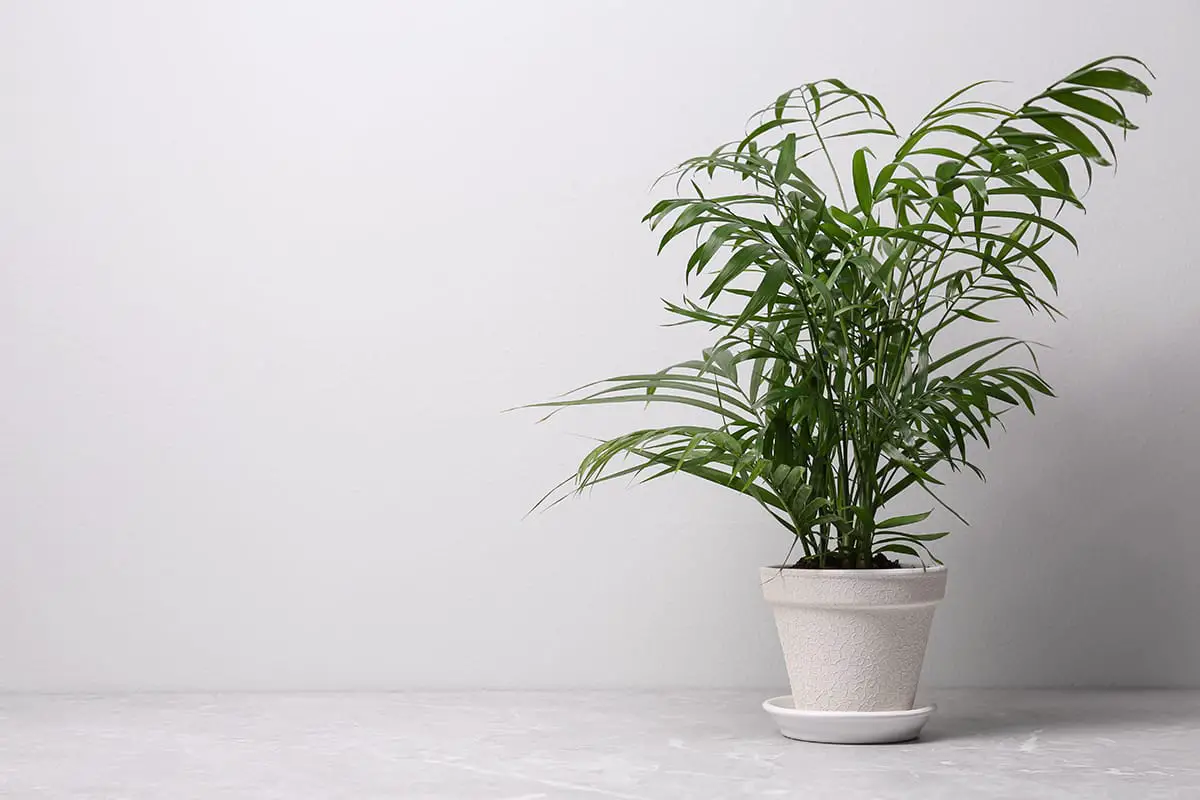
| Botanical name | Ravenea rivularis |
| USDA hardiness zone | 9 – 12 |
| Mature height in a pot | 15 – 40 feet |
In its natural habitat, the Majestic Palm, all called Majesty Palm, is a tall tree reaching heights of around 100 feet; however, when kept in a pot, this height will be heavily restricted. Depending on the level of care it receives, when grown in a pot, this plant will top out at anywhere between 15 and 40 feet. It enjoys wet and humid conditions.
Cat Palm

| Botanical name | Dypsis lutescens |
| USDA hardiness zone | 9 – 11 |
| Mature height in a pot | 6 feet |
Cat palm is a dense, clumping, trunkless palm, which makes it ideal for creating privacy borders around a swimming pool or the boundary of a garden. It produces long feathery green fronds, creating a tropical vibe in an outdoor pot. It can grow in full sun or dappled shade but will need plenty of water to keep the soil moist.
Chinese Fan Palm

| Botanical name | Livistona chinensis |
| USDA hardiness zone | 9 – 11 |
| Mature height in a pot | 10 feet |
This is a stunning specimen plant, with its large, stiff fronds that form the shapes of open fans. The Chinese Fan Palm is a multi-stemmed plant that lacks the main trunk, giving it a look of a large shrub when kept in a pot. It is tolerant of drought and can be grown in partial sun or full sun.
European Fan Palm
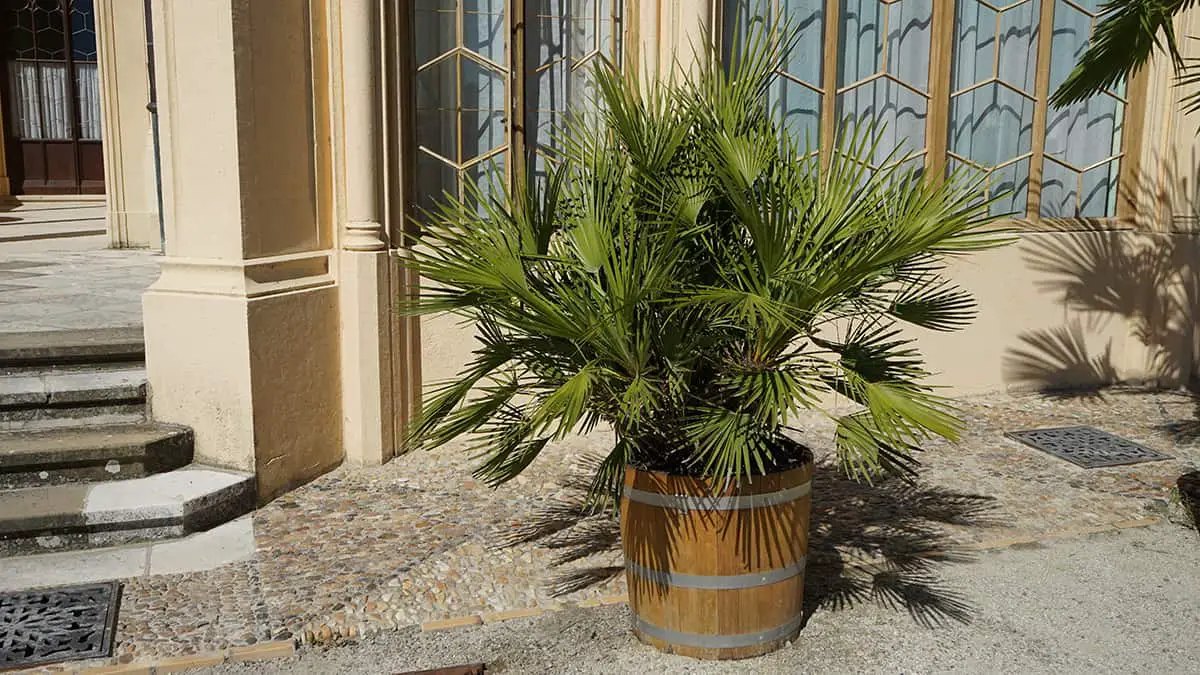
| Botanical name | Chamaerops humilis |
| USDA hardiness zone | 8 – 11 |
| Mature height in a pot | 10 feet |
This is more cold hardy than most palms, being the only palm native to Europe. Low temperatures can damage the foliage, but the trunk will survive and sprout new leaves the following season. The European Fan Palm is known for being well-suited to container growing.
It is a multi-trunked plant with large fan-shaped fronds. It can also be grown as a single-trunked tree if the suckers are removed as they appear. This palm requires sunny conditions but is very drought tolerant.
Bamboo Palm
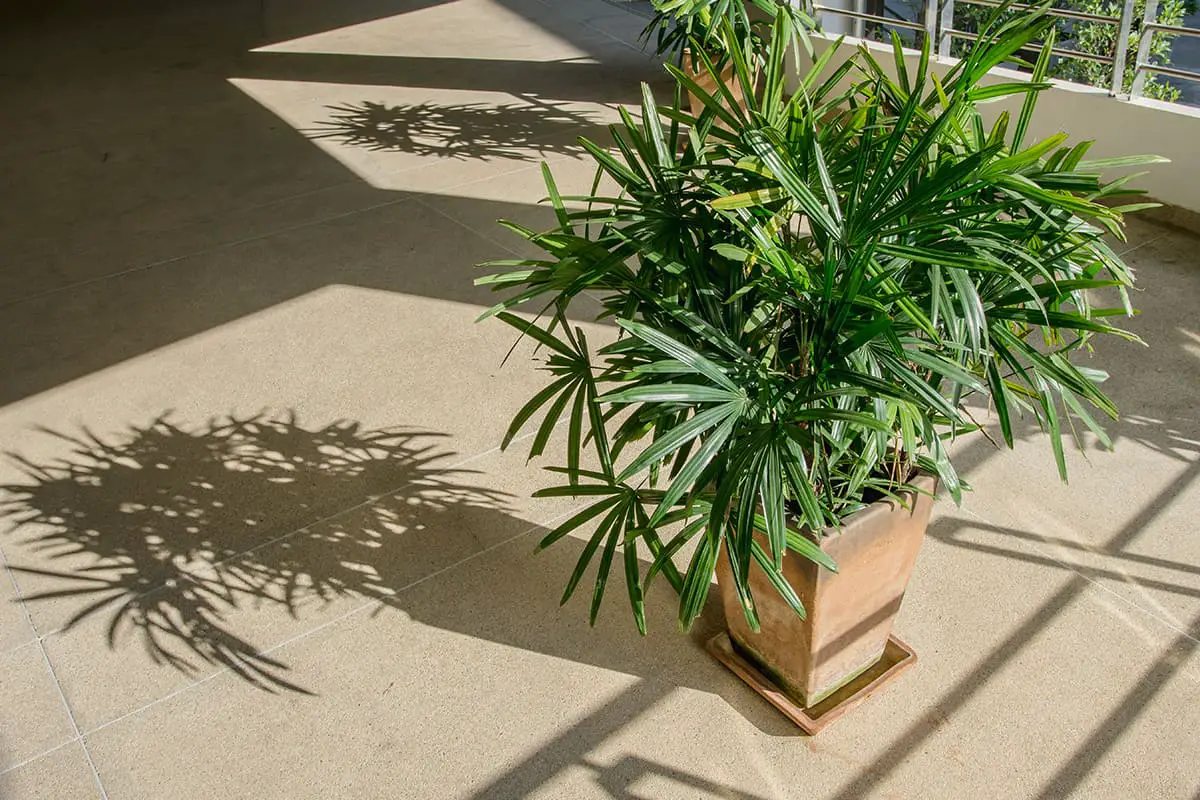
| Botanical name | Chamaedorea seifrizii |
| USDA hardiness zone | 10 – 12 |
| Mature height in a pot | 5 to 10 feet |
The Bamboo Palm is commonly grown in rows of pots as privacy screening or as a hedge. It strongly resembles bamboo, with clusters of fronds growing on tall canes. It has a clumping habit and grows well in both full sun and light shade. It can reach heights of up to 10 feet when grown in a pot but will require plenty of suns to do so.
Fishtail Palm

| Botanical name | Caryota mitis |
| USDA hardiness zone | 9 – 11 |
| Mature height in a pot | 20 feet |
The foliage of fishtail palm means that it stands out easily against other palms but still provides a tropical look. The name of the plant comes from the shape of the leaves, which have jagged edges that give them the look of fishtails.
This is an ideal palm for creating shade, since it grows to be quite tall with dense foliage.
Lady Palm
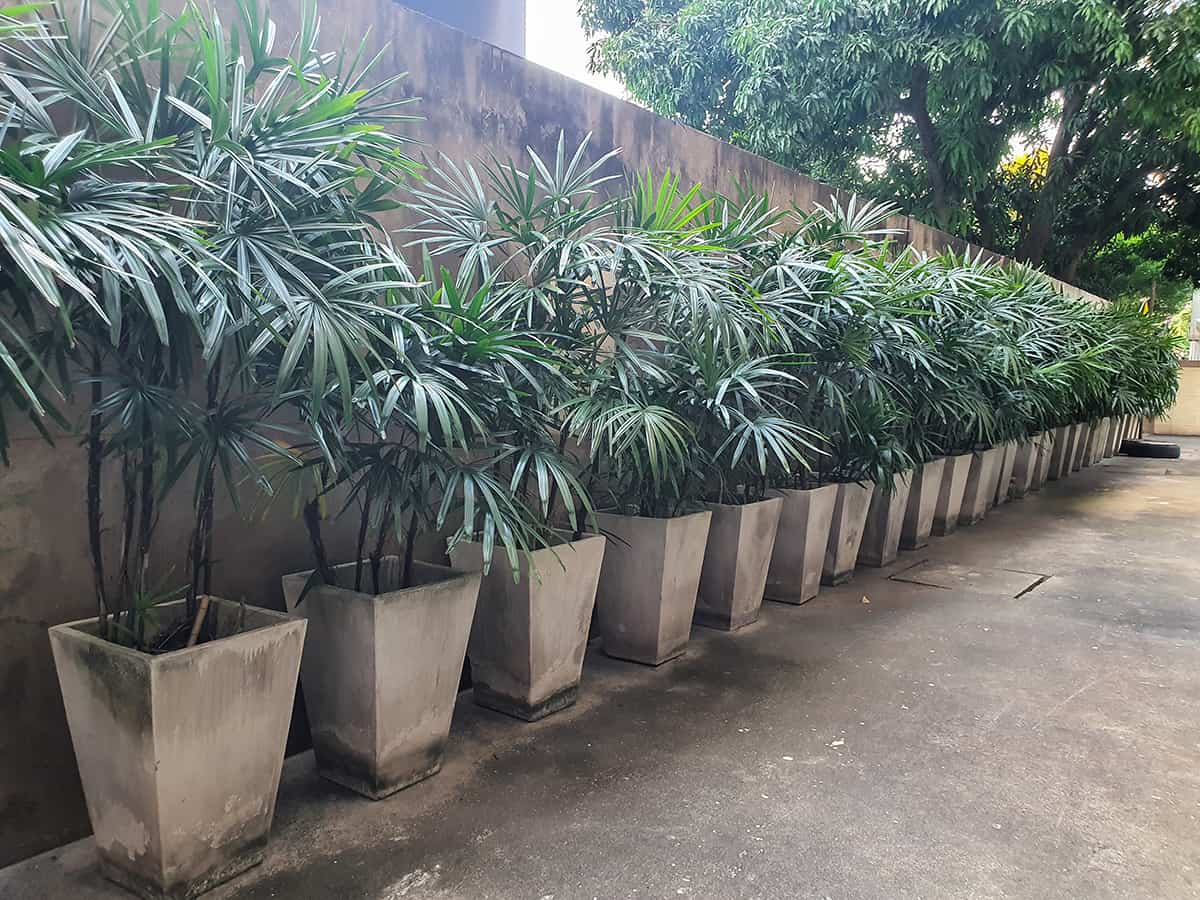
| Botanical name | Rhapis excelsa |
| USDA hardiness zone | 9 – 11 |
| Mature height in a pot | 13 feet |
This is a slow-growing palm that produces clumping bamboo-like canes with sprouting fronds of foliage. It is a robust plant that thrives in partial shade or full shade, and its slow-growing nature means that it will remain happy in the same pot for many years.
Pygmy Date Palm
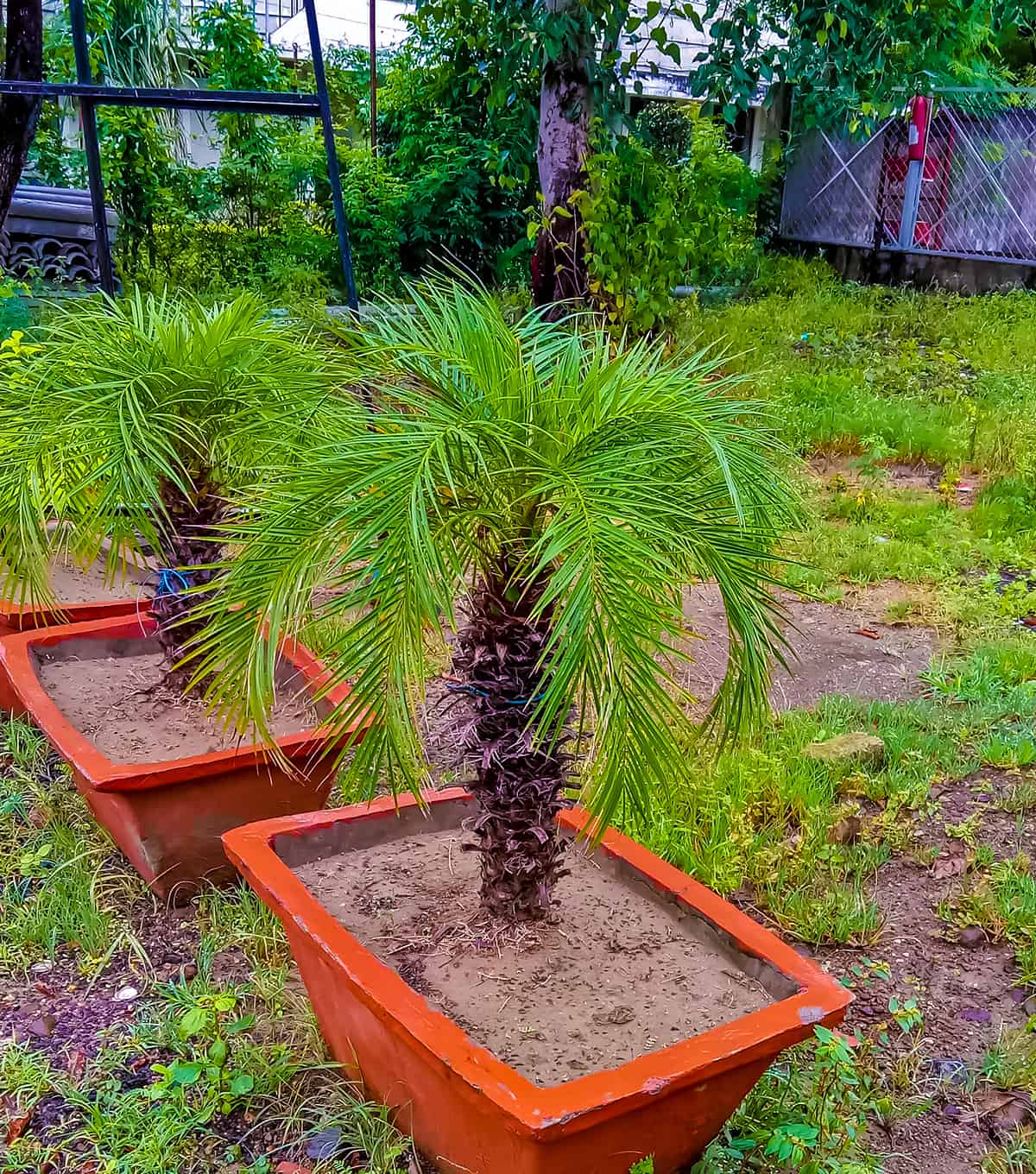
| Botanical name | Phoenix roebelenii |
| USDA hardiness zone | 10 – 11 |
| Mature height in a pot | 6 feet |
This is a dwarf species of palm that is ideal for growing in a pot. It produces slender fronds on gently arching stems, along with date fruits which tend not to be as sweet as those of the Date Palm. Allow it plenty of sunlight and shade it during the hottest hours of the day.
Lipstick Palm
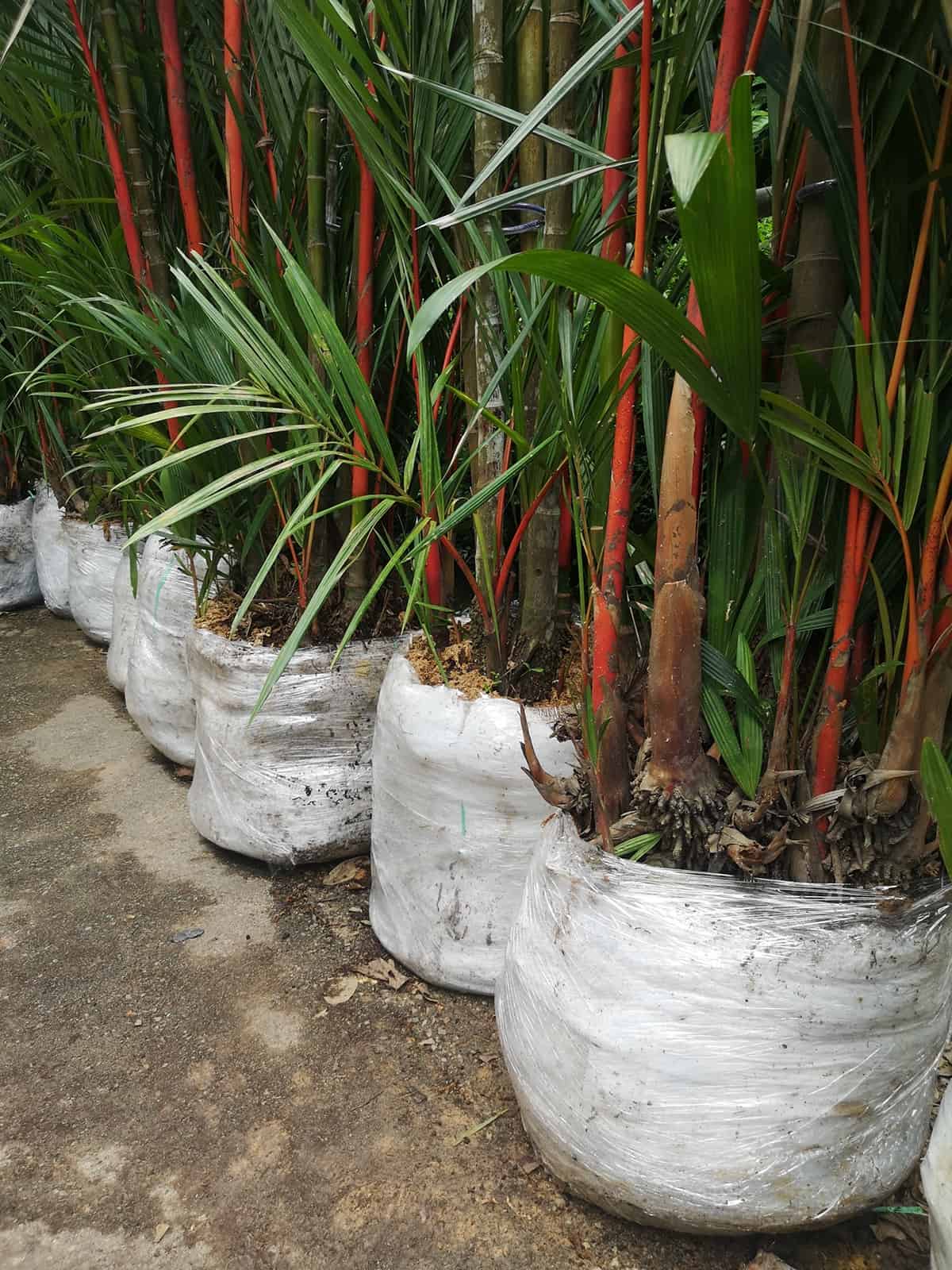
| Botanical name | Cyrtostachys renda |
| USDA hardiness zone | 10 – 11 |
| Mature height in a pot | 25 feet |
This unusual palm produces bold red stems and contrasting bright green fronds, making it ideal for adding color to a patio or terrace. Unfortunately, it can be a tricky plant to keep alive since it is not tolerant of cold, heat, salt, drought, or wind.
Bismarck Palm
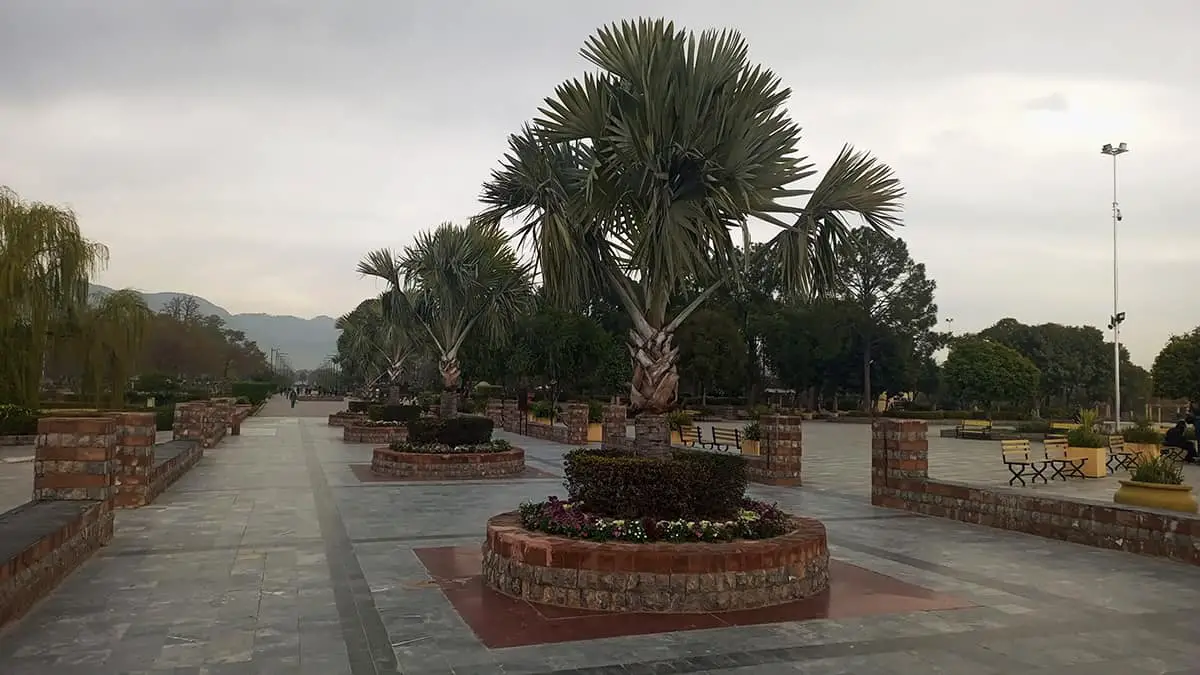
| Botanical name | Bismarckia nobilis |
| USDA hardiness zone | 10 – 11 |
| Mature height in a pot | 40 feet |
The Bismarck Palm is native to Madagascar. This is a striking specimen plant that produces blue-gray, firm star-shaped fronds. It can grow well in a container for as long as a decade but will eventually need to be transplanted into the ground due to its size.
How to Choose a Palm for a Pot
Consider height
If you try to grow a palm tree that is going to get very tall in a pot, then it is going to become unstable when it reaches a certain height. It will be vulnerable to falling over in windy weather or stormy conditions. Instead, opt for a smaller variety of palm tree which will not topple at the first sign of a breeze.
Consider growth rate
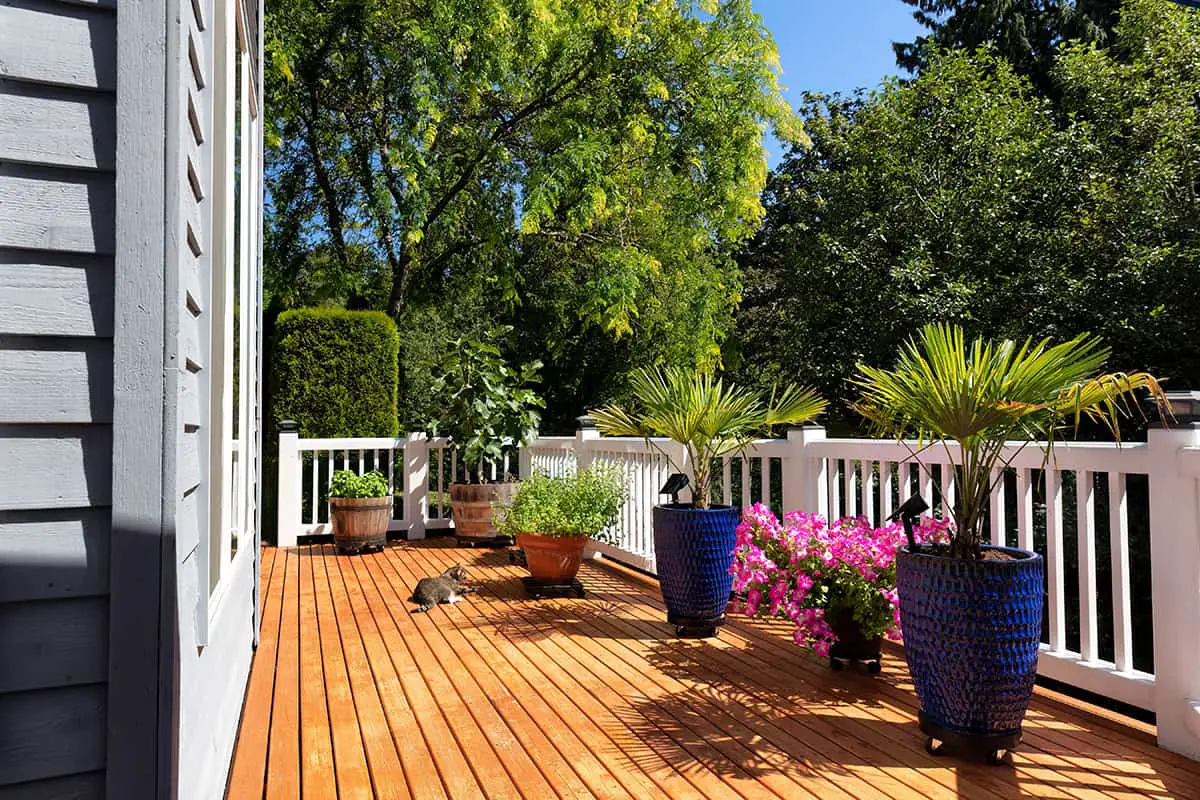
Many palm trees are known for their ability to grow quickly, adding several feet to their height each year. These are the palm trees you want to avoid growing in pots because they will outgrow their pots in a rapid time and need to be repotted as often as every year.
Repotting a sizable palm tree is quite a difficult task, so it isn’t something that most gardeners want to be doing on a frequent basis. Instead, choose a slower-growing palm that can live for longer in the same pot.
Consider usage
There are many reasons for choosing a potted palm to have in your garden, and the qualities you want from your palm can help you to figure out which species is going to be best.
For example, if you want a row of potted palms to create privacy in your garden, then you’ll want to choose a palm tree that has dense foliage and lacks a trunk, such as the Cat Palm tree. If you want a low-maintenance garden, then a tough palm that can tolerate a range of care levels, such as the Kentia Palm, would be a good option. If you want a potted palm to create dappled shade for smaller plants, then the Areca Palm will work well since it grows to heights of up to 20 feet when grown in a pot and has large feathery fronds.
Consider climate and care requirements.
Not all palms have the same climate and care requirements, so be sure to investigate a palm’s needs before you commit to buying one. If you are in a warm climate within USDA hardiness zones 9-12 then there will be many species of palm trees available to you because many palms enjoy tropical weather.
However, there are some hardier palms, such as the Needle Palm tree, which can grow well in an outdoor pot in cooler climates down to the USDA hardiness zone 6. You should also think about the space you want to position your pot in and what level of light it will receive there.
Some palms will want full sun all day long, such as the Ponytail Palm, whereas others, like the Parlor Palm prefers dappled shade or full shade. Choosing a potted palm that best suits your local climate and the type of care you can offer it will ensure it thrives and fulfills its best potential.
Best Pots for Potted Palms
Choosing the type of palm you want isn’t the only decision to make when it comes to selecting potted palms. You’ll also need to choose a pot to house your palm, and getting this right can help to keep your palm tree healthy and thriving.
Pot Material
Terracotta pots, which are made from unglazed clay, are a popular choice for outdoor planters, and they can work well for palm trees depending on your local climate and the type of palm you have. Terracotta pots are heavy, which makes them well suited to tall palms because it helps to anchor them to the ground and prevent them from toppling over.
These types of pots are known for their ability to wick moisture from the soil, which is great if you have a palm with low moisture needs, such as the Kentia Palm, but this could be a disadvantage to many palms which need to grow in consistently moist soil. Terracotta pots are quite thick, which allows them to provide some protection and insulation to the roots of the plant during drops in temperature.
If you are at the lower end of the recommended hardiness zone for your palm, this could help your plant survive the winter. Terracotta pots have a rustic and neutral look that works well with tropical style decor, so aesthetically they look great with every type of palm.
If you have a palm that prefers wet conditions, then a plastic planter will work well because it won’t wick any moisture from the soil.
Pot Size
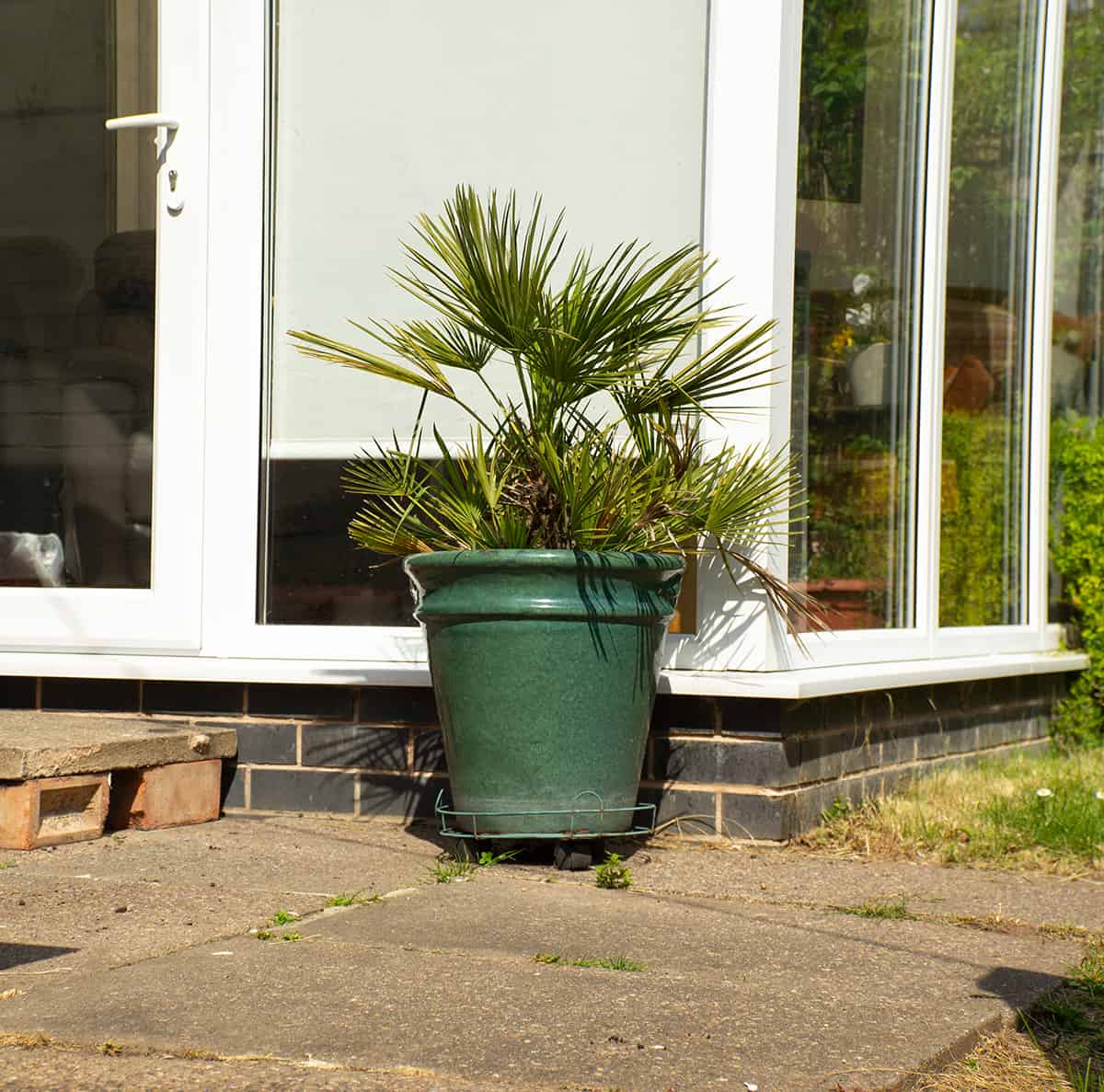
Palms like to fit quite snugly into their pots, so don’t choose an excessively large pot for your plant. Assess the size of the root ball, and choose a pot that is around 4 inches wider than this. This will ensure the roots of your palm feel secure while allowing some growing room.
Pot Drainage
Drainage holes in outdoor plant pots are absolutely essential, even for palms that like wet conditions. If the pot fills up with water in a rainstorm, the drainage holes will allow excess moisture to escape. Without these, standing water in the pot can lead to root rot.
